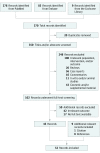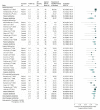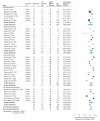Efficacy and Safety of Autologous Fat Transfer in Facial Reconstructive Surgery: A Systematic Review and Meta-analysis
- PMID: 29596574
- PMCID: PMC5876814
- DOI: 10.1001/jamafacial.2018.0102
Efficacy and Safety of Autologous Fat Transfer in Facial Reconstructive Surgery: A Systematic Review and Meta-analysis
Abstract
Importance: The use of autologous fat transfer (AFT) or lipofilling for correcting contour deformities is seen as one of the major breakthroughs in reconstructive plastic surgery. Its applications in facial reconstructive surgery have been of particular interest owing to the prospect of achieving autologous reconstruction by a minimally invasive approach. However, its unpredictability and variable degree of resorption have limited its utility and much skepticism still exists regarding its efficacy. Furthermore, more than 2 decades of clinical research have produced a highly fragmented body of evidence that has not been able to provide definite answers.
Objective: To investigate the safety and efficacy of AFT in facial reconstruction through a systematic review and meta-analysis.
Data sources: A literature search was performed in PubMed, Embase, and the Cochrane Library from inception to October 11, 2017.
Study selection: All published studies investigating the efficacy and safety of AFT in facial reconstructive surgery.
Data extraction and synthesis: Two independent reviewers performed data extraction systematically, adhering to the PRISMA guidelines. Summary measures were pooled in a random-effects model meta-analysis.
Main outcomes and measures: The patient and surgeon satisfaction, graft survival, number of AFT sessions, and the incidence of AFT-related complications were the main outcomes of interest in this meta-analysis.
Results: This systematic review resulted in the inclusion 52 relevant studies consisting of 1568 unique patients. These included 4 randomized clinical trials, 11 cohort studies, and 37 case series. The overall follow-up averaged 1.3 years after AFT. Meta-analysis revealed a very high overall patient satisfaction rate of 91.1% (95% CI, 85.1%-94.8%) and overall surgeon satisfaction rate of 88.6% (95% CI, 83.4%-92.4%). The number of AFT sessions required to achieve the desired result was 1.5 (95% CI, 1.3-1.7) and 50% to 60% of the injected volume was retained at 1 year. Only 4.8% (95% CI, 3.3%-6.9%) of procedures resulted in clinical complications.
Conclusions and relevance: To our knowledge, this study provides the first overview of the current knowledge about AFT in facial reconstructive surgery. Our results confirm that AFT is an effective technique for treating soft-tissue deformities in the head and neck, with low rate of minor complications.
Level of evidence: NA.
Conflict of interest statement
Figures





Comment in
-
The Potential of Autologous Fat Transfer as a Valuable Tool for Cosmetic and Reconstructive Purposes: Acknowledged Risks, Limitations, and Benefits.JAMA Facial Plast Surg. 2018 Sep 1;20(5):360-361. doi: 10.1001/jamafacial.2018.0126. JAMA Facial Plast Surg. 2018. PMID: 29596624 No abstract available.
References
-
- Higgins JP. G.S.e.C.H.f.S.R.o.I.V.u.M.T.C.C. 2011. http://www.handbook.cochrane.org. Accessed January 31, 2018.
-
- Stroup DF, Berlin JA, Morton SC, et al. . Meta-analysis of observational studies in epidemiology: a proposal for reporting. Meta-analysis Of Observational Studies in Epidemiology (MOOSE) group. JAMA. 2000;283(15):2008-2012. - PubMed
-
- Knobloch K, Yoon U, Vogt PM. Preferred reporting items for systematic reviews and meta-analyses (PRISMA) statement and publication bias. J Craniomaxillofac Surg. 2011;39(2):91-92. - PubMed
-
- WebPlotDigitizer http://arohatgi.info/WebPlotDigitizer. Accessed November 15, 2017.
Publication types
MeSH terms
LinkOut - more resources
Full Text Sources
Other Literature Sources
Medical
Research Materials
